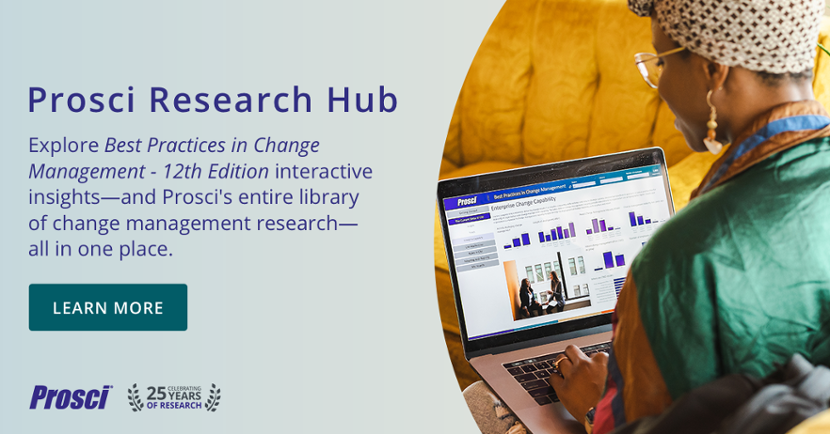5 Tips For Developing People Managers as Leaders of Change
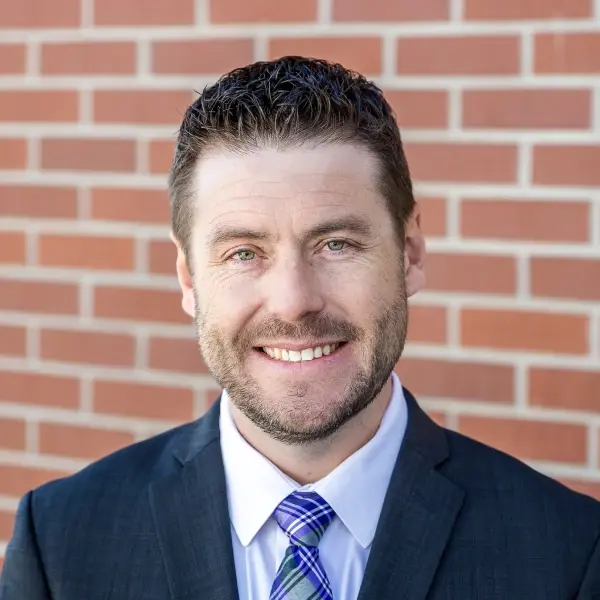
5 Mins
Updated: October 25, 2023
Published: February 21, 2023

Becoming a great leader of change involves learning how to prepare and equip others during change. When you enable people managers with the right knowledge, tools and support, they can grow into well-equipped allies who will engage with their teams and help you move organizational changes forward. Here are five tips to help them succeed.
1. Build Support for the Change
The first step in engaging people managers as leaders of change is getting them on board with the change. People managers must support a change before they can successfully lead their teams through the change process. From an ADKAR perspective, this means that people managers must have sufficient Awareness of the need for change and Desire to participate and support the change before engaging their direct reports. To achieve this, your change management plans need to include specific elements aimed at building support with people managers.
The Communications Plan should have a section focused on people managers, explaining why the change is happening, the benefits of the change, and the nature of the change from the manager’s perspective. These communications should start very early in the project life cycle to ensure adequate time before people managers are asked to communicate with their teams. In addition to general change-related messages, the plan should communicate specific messages about the roles people managers play in change and how to prepare, equip and support their teams.
Get access to Prosci's entire library of change management research, best practices,
and interactive insights when you subscribe to Research Hub.
Research shows that communications are most effective when they come from preferred senders. In the case of people managers, messages should come from leadership and the people manager's direct supervisor. It is critical to use two-way communication to allow for exchanges and feedback.
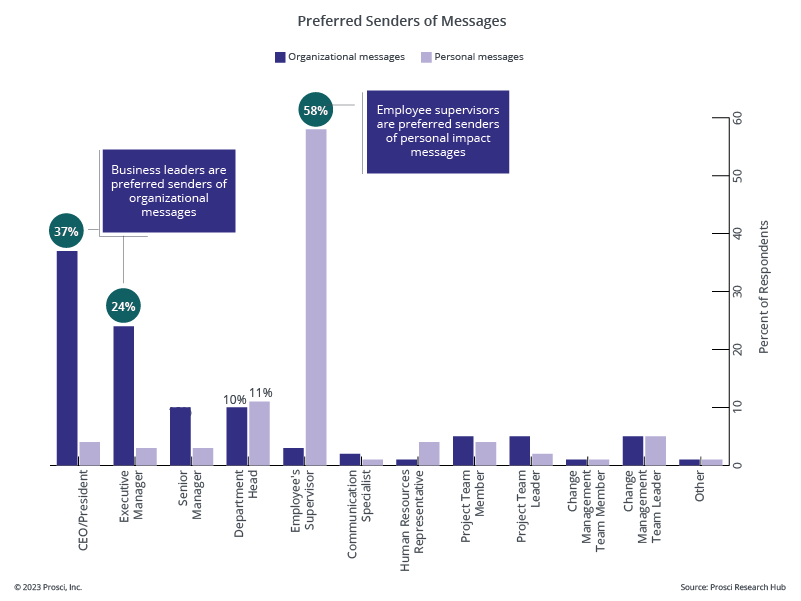
Specific activities in the Sponsor Plan should also focus on people managers. Their leaders, and in some cases the managers themselves, are part of the coalition of leaders needed to drive the change forward.
Finally, resistance management planning should focus on people managers as a group. In Prosci’s most recent benchmarking study, 42% of participants cite mid-level managers as the group most resistant to change. Proactive resistance management activities are built into the Prosci 3-Phase Process at key points in the project lifecycle to mitigate most resistance early on. Plans that address the key concerns of people managers, such as loss of control and workload issues, enable you to anticipate and address resistant behaviors and their root causes.
It is important to note that people managers should first be treated as people first and managers second. Before they can support others through their transitions as leaders of change, you must ensure their support for the change and mitigate any resistance they feel by helping them overcome their individual barriers to change.
2. Share the Role You Expect
Sharing what you expect from people managers occurs at two levels: a high-level expectation about general involvement during change and a more detailed set of expectations about the specific roles people managers play in times of change.
It may seem obvious, but it is critical to tell people managers how important their role is in driving successful change. When people managers don't understand this, they are more likely to abdicate their responsibilities, feel unprepared or make mistakes, and resist the change.
Once your people managers understand the importance of their role, you can move on to expectations about specific activities.
Prosci research identifies five key roles of people managers during change, or CLARC:
- Communicator – to deliver key messages about the change
- Liaison – to enable two-way communication between employees and the project team
- Advocate – to demonstrate support for the change
- Resistance Manager – to identify resistance and help remove individual barriers to adoption
- Coach – to provide training, information and support employees need to adopt and use a change
3. Build Competencies
Leading change is a personal competency that people managers can build, but it is not necessarily natural. It takes a particular set of skills to lead a group of employees through a change process. Even great managers can struggle in times of change. Appreciating this and working to build the competency in people managers is a critical step that is often overlooked.
Participants in our benchmarking research cite the Coach and Resistance Manager roles as the two roles people managers struggle with most. This is because these CLARC roles often represent tasks and challenges outside the general skillsets of managers. Unfortunately, the data also shows that only 35% of study participants say they provide adequate training, preparation and support to managers for their roles in change.
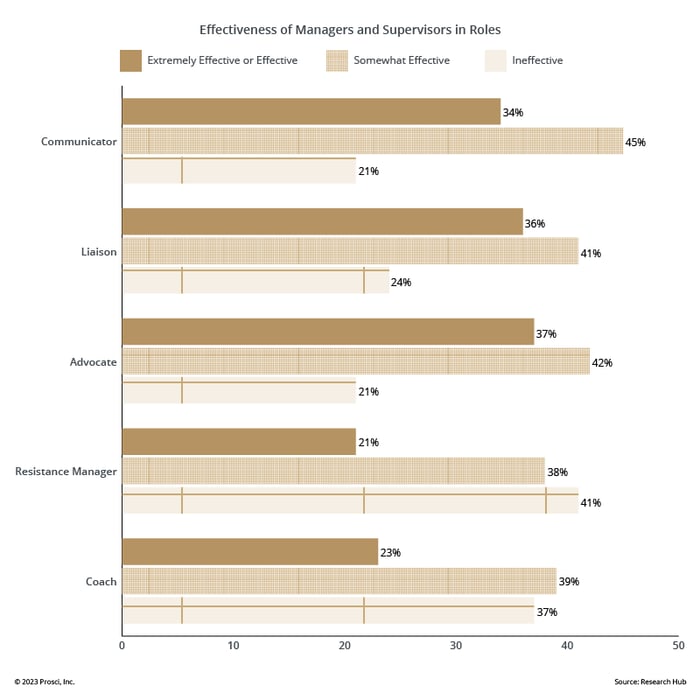
When organizational leaders recognize that “leading change” is a personal competency that managers can build, organizations can begin providing training and professional development opportunities for this critical group. During times of change, having people managers who can lead their teams through change is central to success.
4. Provide Tools
In addition to competencies, people managers need tools for helping their people through changes. One of the most important tools you can provide to people managers is a framework for understanding the people side of change. The ADKAR Model is a model for individual change and a powerful tool in the hands of people managers. By breaking down the change process into a simple and easy-to-use sequence—Awareness, Desire, Knowledge, Ability and Reinforcement—ADKAR gives people managers an approach to understand how a person experiences change.
ADKAR is equally powerful as a tool for identifying where people are experiencing barriers to change. People managers who can put ADKAR into action will have more productive discussions, be able to isolate issues and problems, and ultimately be in a better position to support their people though the change process. And, when changes are better managed at this level, morale and productivity improve.
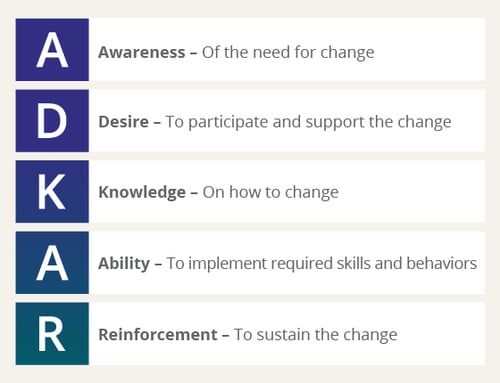 People managers need a number of additional tools from change managers as they serve as leaders of change. A few suggestions include:
People managers need a number of additional tools from change managers as they serve as leaders of change. A few suggestions include:
- Communications materials
The role of the Communicator is one of the five key roles of people managers during change, and it's repeatedly identified in Prosci's Best Practices in Change Management research. But what messages do they need to communicate and when? Change managers need to enable people managers with coaching on effective communication, as well as simple but comprehensive communications materials that include the information they are expected to convey to their direct reports. - Resistance management tools and tips
The role of the Resistance Manager is another key role of people managers during change, and the one that Prosci research participants identified as being most difficult. Offering tools and tips that help people managers know what resistance might look like, where it is likely to show up, and how to identify root causes of resistance is beneficial. Tips and actions for mitigating resistance with impacted people and groups are built into the Prosci 3-Phase Process, along with effective tactics for addressing resistant behaviors when they persist. - Guidelines on how to measure performance
Changes are only successful when employees do their work in a different way, as prescribed by the project or change initiative. People managers are in the best position to identify whether changes are being adopted and used. You can enable them with tools and metrics for understanding whether people are complying with the new way of working.
5. Provide Support
Support is critical when people managers take on their new "leader of change" role with their teams. Some tasks and responsibilities that come with the role are difficult and unfamiliar, and they need outlets and support.
In particular, you will need to help people managers implement the processes and tools for leading change with their teams. Providing opportunities to practice identifying resistance in a safe setting, Q&A sessions, or help delivering key communication messages will enable people managers to grow comfortable and confident in their role. It is also helpful to connect people managers to experienced peers or subject matter experts who can share insights, provide suggestions, and offer feedback on supporting employees through the change process.
Your support as a change practitioner extends well beyond classroom learning and is essential to helping people managers succeed in their role as change leaders.

